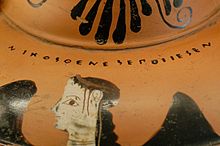- Nikosthenes
-
 Nikosthenes' signature (Nikosthenes epoiesen) on the neck of a black-figure Nikosthenic amphora, ca. 530–520 BC, Louvre
Nikosthenes' signature (Nikosthenes epoiesen) on the neck of a black-figure Nikosthenic amphora, ca. 530–520 BC, Louvre
Nikosthenes was a potter of Greek black- and red-figure pottery in the time window 545-510 B.C. He is thought to have been associated with the work of the painters Oltos, Lydos, Epiktetos and the Nikosthenes-Painter.
Nikosthenes was the owner of one of the largest pottery workshops in Athens in the latter part of the sixth century BCE. He is noted for specializing in production of vases for the Etruscan market. In particular the so-called Nikosthenic amphora, the Attic kyathos and the Nikosthenic pyxis were designed on Etruscan shapes and exported to Etruria with no known local examples in Athens. In spite of this the majority of the production of the workshop was devoted to kylixes and amphora. There is considerable discussion about the size of the workshop. Identification of the products of the workshop are based primarily on the large number (133) vases signed by Nikosthenes epoiesen (Niksothenes made me) and similar variants. The signatures were placed on the vase in glaze (paint) and show a variety of hands and spellings. Added to these vases are vases which can be linked to these vases on the basis of detailed stylistic analysis. Most scholars would accept that it contained about 30 to 40 workers at any one time between 530 and 505. In 1999, V. Tosto attempted to downsize the workshop to a small handful of assistants and temporary workers around Nikosthenes who worked as both painter and potter. This has been rejected by M. Eisman who not only holds for the larger sized workshop but has suggested that Nikosthenes himself came from Chalkis and began working with a small workshop of Anakles around 550 and then developed his own workshop.
The Nikosthenic production while large is not particularly distinguished for its quality. While the vases are well potted and the overall quality of the painting is good there only a few outstanding vases that would hold their own with the more distinguished painters working at that time. In addition to the painters of the Nikosthenic amphora and kyathoi a number of well-known painters were part of the workshop at various times including Psiax, Oltos, the 'BMN Painter" and the 'Theseus Painter'. It is possible that there was a connection with the Andokides workshop which produce very high quality vases in small quantities. One of its primary painters, the Lysippides Painter, may have produced a series of elaborate kylixes with gorgoneion heads in the interior for the workshop. The workshop seems to have passed into the hands of Pamphaios somewhere between 505 and 500 and continued under his direction for a number of years before it disappears somewhere around 490.
Literature
- John Beazley, "Attic Black-figure Vase-Painters, 1954.
- M.M. Eisman, Attic Kyathos Painters, 1971.
- M.M. Eisman, "Nikosthenic Amphorae" The J. Paul Getty Museum Journal I (1974)43-54
- M.M. Eisman, "A Further Note on EPOIESEN Signatures" Jornal of Hellenic Studies, 94 (1974)172
- M.M. Eisman, "Attic Kyathos Production" Archaeology, 28 (1975) 76-82.
- M.M. Eisman, "Nikosthenes and Chalkis" ATINER Conference on European History - 2006, 2007,forthcoming.
- V. Tosto: The Black-figure Pottery Signed NIKOSTHENESEPOSIEN, 1999 (Allard Pierson Series 11)
Pottery of ancient Greece Wine shapes Perfume shapes and wedding shapes Funerary shapes and cultic shapes Storage shapes Techniques Painters Special topics in Greek pottery Typology · Kalos inscription · Symposium · Corpus Vasorum Antiquorum · John Beazley · Panathenaic Amphorae · South ItalianCategories:- Ancient Greek potters
Wikimedia Foundation. 2010.
